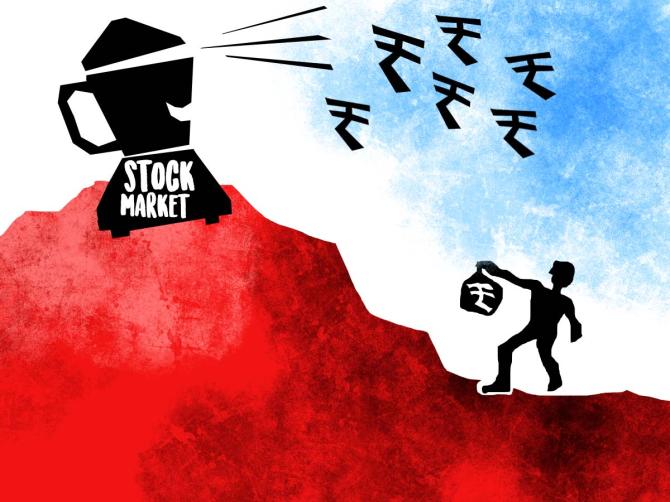'Over the next two quarters, markets will be guided by observing the earnings resilience of corporates during the second lockdown, progress of the monsoon and the damage, if any, to rural spending power due to the second wave.'

"While the reopening of the local and global economy post the Covid second wave lend confidence from a growth standpoint, there are a few risks lurking on the sidelines such as expectations of the US Fed's commencement of its quantitative easing (QE) unwind, firm commodity prices and thereby inflation, and the dangers of the third Covid wave," Taher Badshah, chief investment officer for equities at Invesco Mutual Fund, tells Puneet Wadhwa.
What is the road ahead for the markets? Are there more triggers for a downside rather than catalysts for an upside?
The risk-reward in the market appears evenly balanced.
In the near term, while the reopening of the local and global economy post the Covid second wave lend confidence from a growth standpoint, there are a few risks lurking on the sidelines such as expectations of the US Fed's commencement of its quantitative easing (QE) unwind, firm commodity prices and thereby inflation, and the dangers of the third Covid wave.
Any of these, if they assume centre-stage, has the potential to make the markets vulnerable, particularly at current valuations.
On local factors, over the next two quarters, markets will be guided by observing the earnings resilience of corporates during the second lockdown, progress of the monsoon and the damage, if any, to rural spending power due to the second wave.
As regards the US Fed, how similar/different is the situation as compared to 2013 when it tapered its bond buying post the GFC?
The US Fed has played an outsized role in the stock market since it began providing extraordinary monetary policy accommodation in the global financial crisis.
It is, therefore, not surprising that the US Fed is having such an impact on markets and its every word is being keenly scrutinised.
The key difference versus the QE post GFC is that the economic recovery in the US is far stronger now than was witnessed then, thanks to a more robust banking system which has allowed for credit expansion to take place.
The upshot of this will, however, be that the US Fed will have to be much more sensitive to the inflation outcome induced by this growth recovery than during the post GFC years.
Markets will therefore have to be lot more alert to central bank policy risks over the next 12-18 months.
Which market segment -- large, mid and small-caps -- is likely to be an outperformer in calendar year 2021?
While the overall economic and market set up is conducive for the mid-market segment to continue doing well, their performance and valuation differential over the frontline indices is at the largest ever over the past 12 months and a mean reversion therein can be a distinct possibility.
We think the A-listers out of sectors such as banks, industrials and technology could help bridge this gap in the coming months.
We are also sanguine on parts of consumer discretionary such as autos, infrastructure related activities and select bottom up opportunities in healthcare.
Do you see earnings downgrades over the next couple of months in the backdrop of Covid second wave?
Even as markets have dialed down expectations relative to the start of 2021 owing to the second wave, earnings derived out of globally-oriented businesses, such as commodities and technology may meaningfully cover up for this shortfall.
Strength of the domestic economic recovery in the rest of the year, too, will play an important role in assessing the extent of the deviation for the year as a whole.
In the longer term, the post-pandemic economic recovery, acceleration in manufacturing and infrastructure and government policy/reforms will be key earnings determinants.
We expect India's economic cycle to improve over the next three-four years, which should likely support current valuations.
Can the retail flows compensate for the dip in foreign flows, if any, over the next few months?
While it is always difficult to call out short-term trends on flows, it is interesting to note that domestic flows in the market on average pre-Covid have been twice that of FII flows in the five years to 2019.
This, on average, was half of FII flows in the 10 years between 2005 and 2014.
As the equity ownership penetration steadily increases in India, domestic flows should serve very constructively for our markets.
India Inc has started to slowly pass on the rising input costs to the consumers. How is it likely to impact consumption levels and the related stocks going ahead?
India has been in a relatively benign inflation environment over the past few years and hence tolerance to moderately higher inflation in the near-term should be high.
This argument, however, does get complex when one overlays the impact of the pandemic.
Assuming India is able to avoid an adverse third wave and meaningfully accelerate vaccination, corporates will have an easier path to cover cost inflation without worrying about demand.
Parts of consumer discretionary that were recently impacted by the same should likely benefit.
Moreover, supply-side related pressures of the post-lockdown period should ease globally in the going ahead, which should likely ensure against runaway and very sticky inflation.
What is the road ahead for metal stocks given the recent developments?
Recent developments around the sector may lead to a pause in the relentless rise seen in metal product prices of late.
The medium-term dynamics of the sector still suggest favourable supply-demand trends, which could keep metal commodities reasonably firm but the pricing gradient will be more measured hereon.
Many metal companies should be able to use this environment to materially deleverage in the prevailing scenario -- and this, in my view, should be the central argument if one chooses to invest in them even at current levels.











